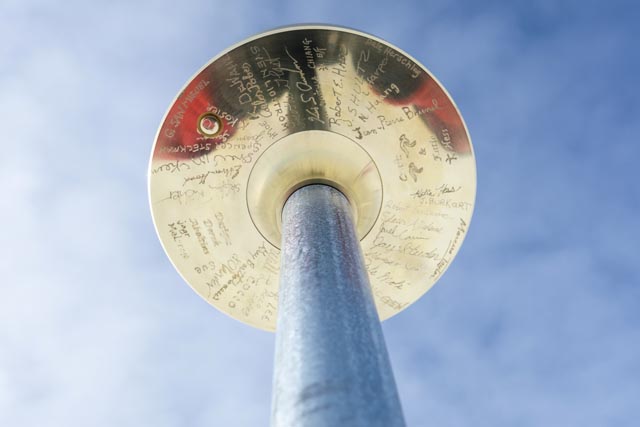|
Return to tradition2013 geographic South Pole marker sports classic stylePosted January 11, 2013
As tradition dictates, on New Year’s Day the geographic South Pole marker was moved to its freshly surveyed position, and the new brass-and-copper plaque that tops the marker was revealed. The Amundsen-Scott South Pole Station The entire South Pole Station staff gathered outside between the old and new pole locations this year and formed a semicircle. Each person helped pass the American flag from its drifted location to the new location just beside the 90 degrees South marker. Almost all hands were present for the ceremony, including station manager Bill Coughran, winter site manager Weeks Heist, and National Science Foundation Once the American flag had been moved, Heist revealed the design of the newly relocated geographic South Pole marker. This year’s marker was created by science machinist Derek Aboltins during the 2012 winter. It was machined out of brass and copper. The marker shows the position of the planets as viewed from the South Pole on Jan 1, 2013. There are seven brass planets displayed on a copper inlay. In the very center is a small copper star that marks the South Pole. It also “represents the earth sciences done from here, as we reach out to understand our planet. The large brass star represents astronomy and astrophysics, as it extends out past our solar system in the quest for knowledge,” Aboltins wrote in his description of the marker. “In the center of the marker (in brass) we have the sun, sunset and moon, with the Southern Cross, including the pointers. If you look carefully, the small inscription above the moon reads, ‘Accomplishment & Modesty.’ This was a reference to honor Neil Armstrong, as he passed away when I was making this section with the moon.” There was even a nod in the design to disenfranchised Pluto: “For those of you who still think Pluto should be a planet, you’ll find it included underneath, just to keep everyone happy,” Aboltins said. “Bring back Pluto, I say!” The previous 2012 South Pole marker was removed from its old location, and a flag was placed in its stead to mark the previous site. The 2012 marker will be displayed at the entrance of the South Pole Station. |



For USAP Participants |
For The Public |
For Researchers and EducatorsContact UsU.S. National Science FoundationOffice of Polar Programs Geosciences Directorate 2415 Eisenhower Avenue, Suite W7100 Alexandria, VA 22314 Sign up for the NSF Office of Polar Programs newsletter and events. Feedback Form |





